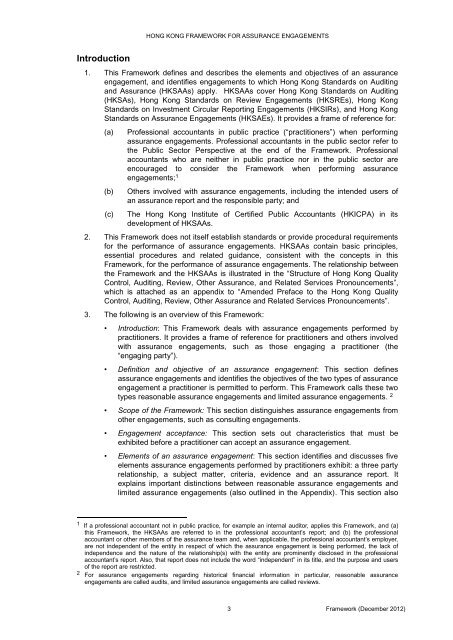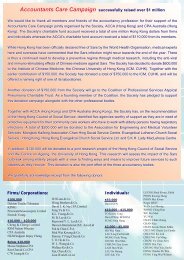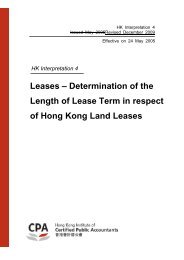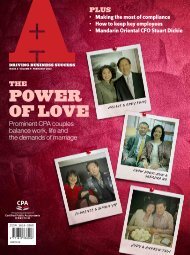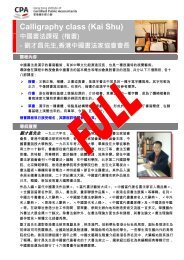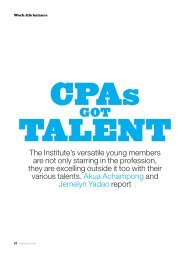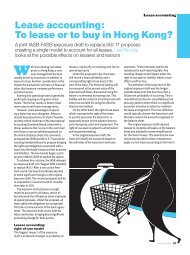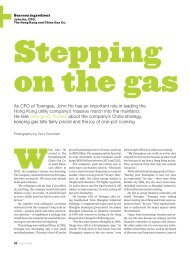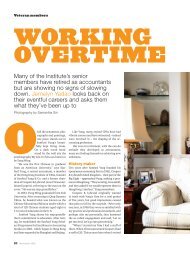Update No. 124 - Hong Kong Institute of Certified Public Accountants
Update No. 124 - Hong Kong Institute of Certified Public Accountants
Update No. 124 - Hong Kong Institute of Certified Public Accountants
Create successful ePaper yourself
Turn your PDF publications into a flip-book with our unique Google optimized e-Paper software.
Introduction<br />
HONG KONG FRAMEWORK FOR ASSURANCE ENGAGEMENTS<br />
1. This Framework defines and describes the elements and objectives <strong>of</strong> an assurance<br />
engagement, and identifies engagements to which <strong>Hong</strong> <strong>Kong</strong> Standards on Auditing<br />
and Assurance (HKSAAs) apply. HKSAAs cover <strong>Hong</strong> <strong>Kong</strong> Standards on Auditing<br />
(HKSAs), <strong>Hong</strong> <strong>Kong</strong> Standards on Review Engagements (HKSREs), <strong>Hong</strong> <strong>Kong</strong><br />
Standards on Investment Circular Reporting Engagements (HKSIRs), and <strong>Hong</strong> <strong>Kong</strong><br />
Standards on Assurance Engagements (HKSAEs). It provides a frame <strong>of</strong> reference for:<br />
(a) Pr<strong>of</strong>essional accountants in public practice (“practitioners”) when performing<br />
assurance engagements. Pr<strong>of</strong>essional accountants in the public sector refer to<br />
the <strong>Public</strong> Sector Perspective at the end <strong>of</strong> the Framework. Pr<strong>of</strong>essional<br />
accountants who are neither in public practice nor in the public sector are<br />
encouraged to consider the Framework when performing assurance<br />
engagements; 1<br />
(b) Others involved with assurance engagements, including the intended users <strong>of</strong><br />
an assurance report and the responsible party; and<br />
(c) The <strong>Hong</strong> <strong>Kong</strong> <strong>Institute</strong> <strong>of</strong> <strong>Certified</strong> <strong>Public</strong> <strong>Accountants</strong> (HKICPA) in its<br />
development <strong>of</strong> HKSAAs.<br />
2. This Framework does not itself establish standards or provide procedural requirements<br />
for the performance <strong>of</strong> assurance engagements. HKSAAs contain basic principles,<br />
essential procedures and related guidance, consistent with the concepts in this<br />
Framework, for the performance <strong>of</strong> assurance engagements. The relationship between<br />
the Framework and the HKSAAs is illustrated in the “Structure <strong>of</strong> <strong>Hong</strong> <strong>Kong</strong> Quality<br />
Control, Auditing, Review, Other Assurance, and Related Services Pronouncements”,<br />
which is attached as an appendix to “Amended Preface to the <strong>Hong</strong> <strong>Kong</strong> Quality<br />
Control, Auditing, Review, Other Assurance and Related Services Pronouncements”.<br />
3. The following is an overview <strong>of</strong> this Framework:<br />
• Introduction: This Framework deals with assurance engagements performed by<br />
practitioners. It provides a frame <strong>of</strong> reference for practitioners and others involved<br />
with assurance engagements, such as those engaging a practitioner (the<br />
“engaging party”).<br />
• Definition and objective <strong>of</strong> an assurance engagement: This section defines<br />
assurance engagements and identifies the objectives <strong>of</strong> the two types <strong>of</strong> assurance<br />
engagement a practitioner is permitted to perform. This Framework calls these two<br />
types reasonable assurance engagements and limited assurance engagements. 2<br />
• Scope <strong>of</strong> the Framework: This section distinguishes assurance engagements from<br />
other engagements, such as consulting engagements.<br />
• Engagement acceptance: This section sets out characteristics that must be<br />
exhibited before a practitioner can accept an assurance engagement.<br />
• Elements <strong>of</strong> an assurance engagement: This section identifies and discusses five<br />
elements assurance engagements performed by practitioners exhibit: a three party<br />
relationship, a subject matter, criteria, evidence and an assurance report. It<br />
explains important distinctions between reasonable assurance engagements and<br />
limited assurance engagements (also outlined in the Appendix). This section also<br />
1 If a pr<strong>of</strong>essional accountant not in public practice, for example an internal auditor, applies this Framework, and (a)<br />
this Framework, the HKSAAs are referred to in the pr<strong>of</strong>essional accountant’s report; and (b) the pr<strong>of</strong>essional<br />
accountant or other members <strong>of</strong> the assurance team and, when applicable, the pr<strong>of</strong>essional accountant’s employer,<br />
are not independent <strong>of</strong> the entity in respect <strong>of</strong> which the assurance engagement is being performed, the lack <strong>of</strong><br />
independence and the nature <strong>of</strong> the relationship(s) with the entity are prominently disclosed in the pr<strong>of</strong>essional<br />
accountant’s report. Also, that report does not include the word “independent” in its title, and the purpose and users<br />
<strong>of</strong> the report are restricted.<br />
2 For assurance engagements regarding historical financial information in particular, reasonable assurance<br />
engagements are called audits, and limited assurance engagements are called reviews.<br />
3 Framework (December 2012)


